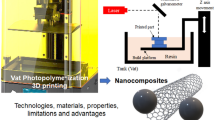Abstract
The joining of metal and polymer surfaces is a promising technology to reduce the total weight of parts and to improve interface reliability. In this study, a micro square grid (200 μm × 200 μm) was fabricated on an aluminum surface using laser ablation. Molten glass-reinforced poly(butylene terephthalate), poly(styrene) and acrylonitrile–butadiene–styrene were introduced to the micro square grids by a precise injection molding machine. The maximum load tensile test was used as a measure of the joining strength between aluminum and the polymer. The tensile strength tests assisted in the differentiation of three modes of separation: interface-peeling, cohesive failure and matrix fracture. The maximum load increased with the effective joined area where interface-peeling was observed. The maximum load ceased at a certain effective joined area, and matrix fracture occurred. Cohesive failure was observed where the effective joined area was smaller than the area for which matrix fracture was observed, and the joined strength was larger than that observed for interface-peeling. The maximum stress, which was calculated by dividing cross-sectional area by the maximum load, at the matrix fracture was proportional to the polymer tensile strength.













Similar content being viewed by others
References
Amancio-Filho ST, dos Santos JF (2009) Joining of polymers and polymer–metal hybrid structures: recent developments and trends. Polym Eng Sci 49:1461–1476
Grujicic M, Sellappan V, Omar MA, Seyr N, Obieglo A, Erdmann M, Holzleitner J (2008) An overview of the polymer-to-metal direct-adhesion hybrid technologies for load-bearing automotive components. J Mater Process Tech 197:363–373
Lucchetta G, Marinello F, Bariani PF (2011) Aluminum sheet surface roughness correlation with adhesion in polymer metal hybrid overmolding. CIRP Ann Manuf Tech 60:559–562
Ramani K, Moriarty B (1998) Thermoplastic bonding to metals via injection molding for macro-composite manufacture. Polym Eng Sci 38:870–877
Ramani K, Tagle J (1996) Process-induced effects in thin-film bonding of PEKEKK in metal–polymer joints. Polym Compos 17:879–886
Ramani K, Zhao WP (1997) The evolution of residual stresses in thermoplastic bonding to metals. Int J Adhes Adhes 17:353–357
Tosello G, Gava A, Hansen HN, Lucchetta G, Marinello F (2009) Characterization and analysis of weld lines on micro-injection moulded parts using atomic force microscopy (AFM). Wear 266:534–538
Tosello G, Gava A, Hansen HN, Lucchetta G (2010) Study of process parameters effect on the filling phase of micro-injection moulding using weld lines as flow markers. Int J Adv Manuf Tech 47:81–97
Author information
Authors and Affiliations
Corresponding author
Rights and permissions
About this article
Cite this article
Taki, K., Nakamura, S., Takayama, T. et al. Direct joining of a laser-ablated metal surface and polymers by precise injection molding. Microsyst Technol 22, 31–38 (2016). https://doi.org/10.1007/s00542-015-2640-2
Received:
Accepted:
Published:
Issue Date:
DOI: https://doi.org/10.1007/s00542-015-2640-2




